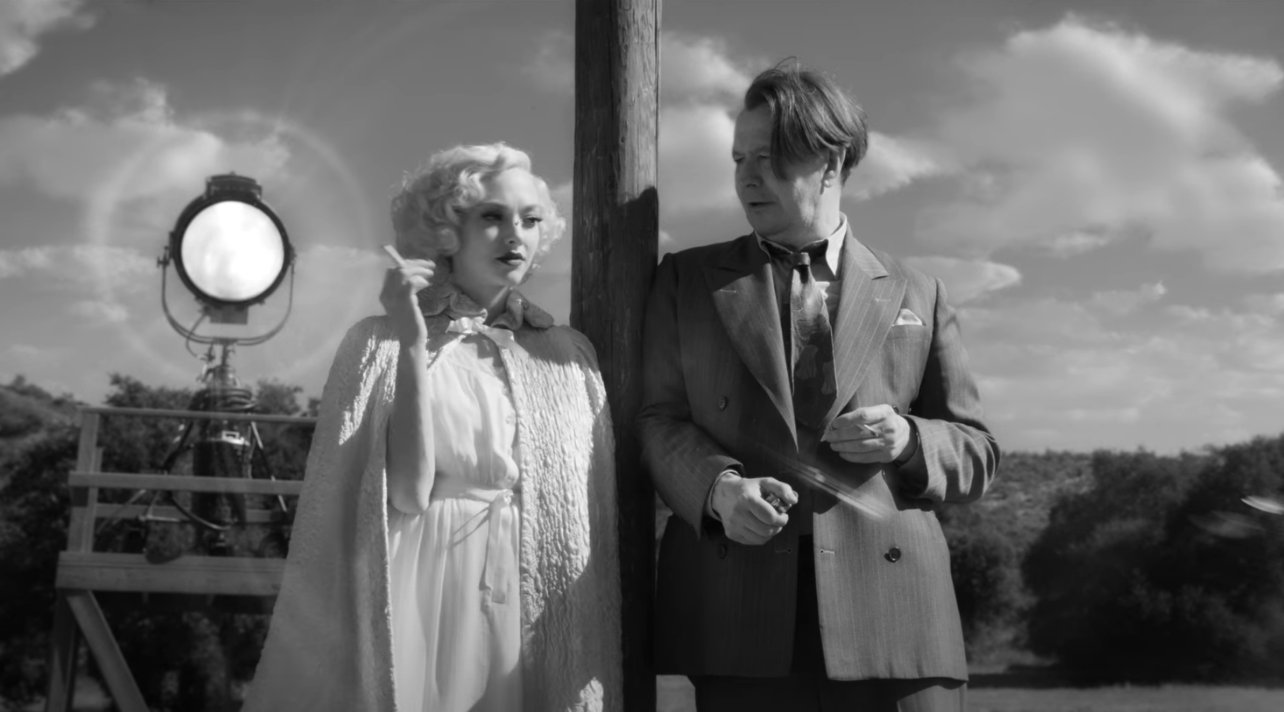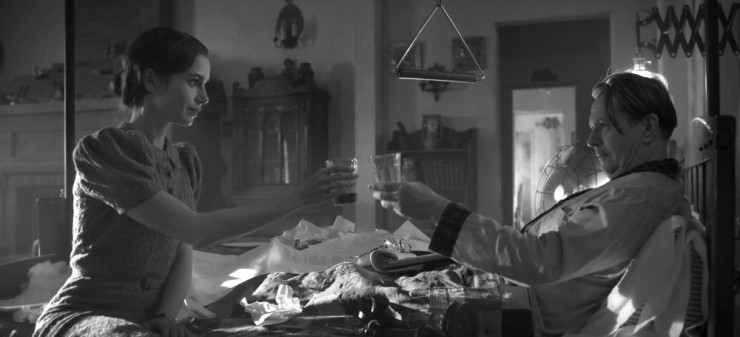Watching a David Fincher movie is like looking at the inside of a beautiful clock: it looks so simple and beautiful on the outside, but seeing all the moving gears and machinery on the inside is intimidating. The director has earned his iconic status for making ice-cold thrillers and character studies about the methodical nature of the worst people. He complements those aspects by having other moving pieces (whether they be characters or the insides of other machines) working in lock-step with each other around the main plot. Fincher doesn’t so much balance the elements in his movies as he does rearrange and connect them like robot arms building a car. With all the perfectionism he applies to his craft, he would be a likely candidate to capture the manic attitude and high-brow executives of 1930s Hollywood. Judging from his latest effort, he might be too good at it.
It’s 1940 and an enthusiastic upstart named Orson Welles (Tom Burke) is working on a new movie for RKO Pictures that will soon live in infamy. But before he mentions a sled on film, Welles wants someone to help him write his screenplay. Enter Herman J. Mankiewicz (Gary Oldman), aka Mank, part-time screenwriter and full-time Hollywood schmoozer drinking and gambling and stumbling over himself to do more drinking and gambling. Welles recruits him to help write his movie, but producers at RKO don’t trust the exiled insider to get the work done. So much so that not only is he not getting credited for the work he’s going to do, but he’s locked in the Mojave desert and stripped of his vices while dictating his vision of the script to a stern typist (Lily Collins). While writing and struggling, he flashes back to his days on movie lots and parties dealing with the likes of stars like Marion Davies (Amanda Seyfried), studio big shots like Louis B. Mayer (Arliss Howard) and media insiders like William Randolph Hearst (Charles Dance).

Photo Credit: Netflix
While he’d never admit it, this might be the most fun Fincher has ever had making a movie. Like Quentin Tarantino’s Once Upon a Time…in Hollywood, the detail in recreating a classic Hollywood era is impeccable. Everything from the speech patterns to the cigarettes to the cars to the clothes (or “gowns” as they’re shown in the credits) are time-accurate and add plenty of character to the movie’s presentation. Even the movie’s technical details fit with the times, not only with the black-and-white cinematography by Erik Messerschmidt (who also worked on Fincher’s Mindhunter) but also in the sound design and mixing that has occasional audio crackles and slightly-muffled dialogue. Fincher is known to be a perfectionist and Mank has plenty of details for Fincher to organize. Aside from the usual wide cast of self-obsessed characters bouncing off of each other, there aren’t many “Fincher-isms” in Mank. It makes for a real outlier in Fincher’s overall catalog.
Mank also has traits of a typical movie about movies, with droll dialogue about the blase business of Hollywood going on at dashing parties or smoke-filled offices. It has the nostalgia and humor of the Coen brothers’ Hail, Caesar! with the cynicism and character-emphasis of Robert Altman’s The Player. What makes the script, first penned by Fincher’s father Jack before he died in 2003, a bit overstuffed is when it further defines itself as a 1930s period piece. When Mank is focused on its title character bedridden and wallowing in sober self-pity, it slows down to be more grounded and focused. But most of the times Fincher flashes back to Mank in his glory days on studio lots, his characters are off to the races babbling about so much business squabbling and gossip that it’s hard to keep track of what’s essential to the story and what’s just color for the times. In those flashbacks, which make up about 75 percent of the movie, Mank doesn’t feel like the one to pay attention to and instead shot around like a pinball between subplots of pompous studio execs, communism vs. socialism, the Great Depression and Upton Sinclair’s run for governor in 1934. The latter and the communism vs. socialism arguments likely felt like events tied to today’s landscape, but they’re touched on in such small and rapid amounts that they slide off the mind as the movie goes on. In the end, Mank ends up being about a fight for control of one’s self in the view of others. But Fincher has too many pieces to put together and the connection of all of the movie’s elements feels forced together rather than seamless links.

Photo Credit: Netflix
While Mank juggles being a drama and a biography, its actors have the energy worthy of a classic comedy. Oldman in particular is as funny as he’s every been in his lengthy career, not ironically funny like his goofy villain in The Fifth Element but with the drunken stupor and pomposity of a classic movie star. Fortunately he doesn’t play Mank entirely as a buffoon, eventually revealing the writer as the classic tragedy using his vices to block out his failures. Fortunately he has a talented cast of actresses to make him show the human side of the screenwriter. Collins has little screen time but she makes the most of it by fully committing to her old-timey military wife backstory while still challenging Mank’s stubbornness. The real surprise comes from Seyfried, a dead-ringer for a classic 30s starlet; equal parts ditzy and independent. Even the roles of the media big wigs are played with a timeless old-man villainy (though it’s hard not to bring that when you’re Charles Dance).
There’s a lot shoved into Mank, so much so that the overall movie becomes so dense to the point of being impregnable. It’s clearly a very personal project for Fincher and his craftsmanship remains impressive, but the story tries to cover so much ground that it’s easy to get lost in Mank’s wild world. A story like this shouldn’t need a corkboard, push pins and multiple strings to connect everything like the mysteries of Mindhunter. At least Fincher is also trying to make season three happen.
Mank is now streaming on Netflix.
Advertisement
Advertisement







